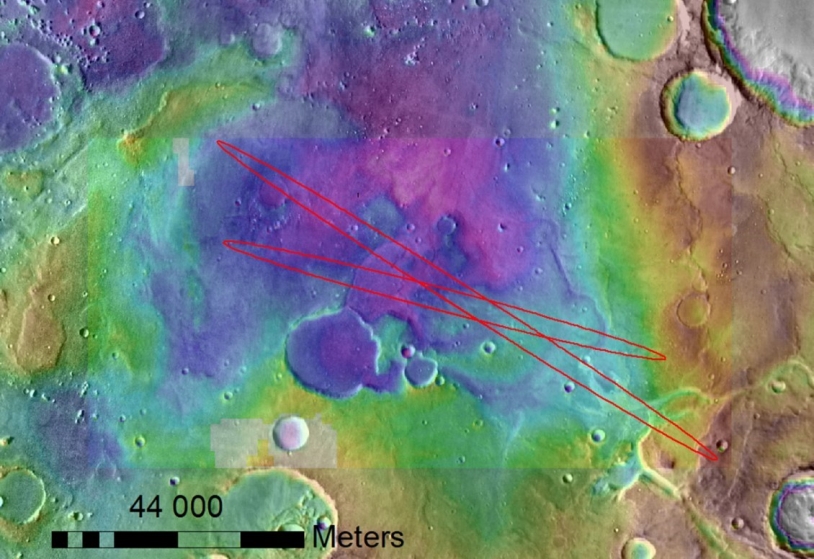ExoMars 2020 - Oxia Planum selected as landing site
Oxia Planum—the clear winner
European scientists and engineers met at the UK’s National Space Centre in Leicester on 8 and 9 November to select the landing site for the ExoMars 2020 mission. The final two candidates—Mawrth Vallis and Oxia Planum—were recommended by two international teams, each led by a French laboratory. While both sites fulfil the mission’s science goals of sampling ancient clay-bearing sediments, Oxia Planum offers greater safety margins for the crucial landing phase and for the rover’s mobility. Nevertheless, Mawrth Vallis remains an exceptional site to be explored in the future. OMEGA has detected vast expanses of hydrated clay at both sites, and combining these data with those collected by US orbiters made it possible to characterize the sites in detail. The teams were able to process massive quantities of Martian orbital data using IAS’s Planetary Surface Portal (http://psup.ias.u-psud.fr/).
Ancient Martian sediments
Oxia Planum is located on the edge of an ancient basin called Chryse Planitia and features thick sedimentary clay deposits that date back more than four billion years. Similar clay deposits have been detected at many other—equally ancient—sites on the planet, pointing to a formation process caused by the action of water at planetary scale. The structure and composition of these deposits mean they could be lagoon or marine deposits, testifying perhaps to the existence of an ancient Martian ocean according to results presented by the site’s proposing team (Quantin, Carter et al. 2018). The science goal of ExoMars 2020 is to detect potential traces of life in samples extracted from up to two metres below the surface, using a drill-hole system. This will ensure that the Martian samples collected have been protected from cosmic bombardment, which destroys organic matter.
ExoMars 2020 will carry an observation and analysis laboratory
Scheduled to land on Mars in Spring 2021, the ExoMars 2020 mission will feature a Russian surface platform fitted with Russian and European instruments, to take environmental measurements over an entire Martian year (687 Earth days). Its onboard European rover will be fitted with nine science instruments dedicated to surface study and analysis.
CNES and the French laboratories are in charge of two of the rover’s instruments—WISDOM and MicrOmega. France is also involved in the development of three further instruments—RLS, CLUPI and MOMA:
• WISDOM is a ground penetrating radar that will provide images of the top few metres of the subsurface and thereby guide the type and location of the drill hole;
• MicrOmega is a near-infrared hyperspectral microscope that will characterize minerals at grain level and identify any potential carbon elements in the drilled samples;
• RLS (in cooperation with Spain) is a Raman spectrometer to fine-tune the identification of minerals and organic matter;
• CLUPI (in cooperation with Switzerland) is a Close-UP Imager for observing rocky outcrops, the drill hole and the samples obtained;
• MOMA (in cooperation with Germany and the USA) is a chemical analysis laboratory that uses a gas chromatograph-mass spectrometer to characterize organic matter.
CNES has also provided software for the visual navigation of the ExoMars 2020 rover.
The four other instruments installed on the rover are:
• PanCam (developed by the UK) is a panoramic camera
• ISEM (developed by Russia) is an infrared spectrometer
• Adron (developed by Russia) is a neutron detector
• Ma_MISS (developed by Italy) is an infrared spectrometer installed in the drill head in order to study the subsurface.
_____
CONTACTS
Pascale Bresson Press Officer Tel: +33 (0)1 44 76 75 39 pascale.bresson@cnes.fr
Raphaël Sart Press Officer Tel: +33 (0)1 44 76 74 51 raphael.sart@cnes.fr

 cp181-2018_-_choix_site_datterrissage_exomars_2020_va.pdf (pdf - 382.99 KB)
cp181-2018_-_choix_site_datterrissage_exomars_2020_va.pdf (pdf - 382.99 KB)